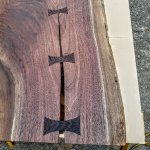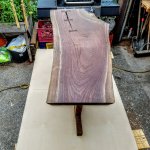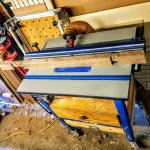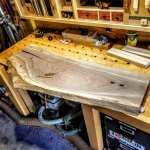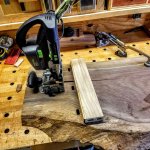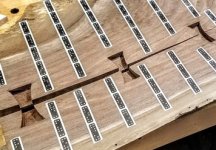ear3
Member
- Joined
- Jul 24, 2014
- Messages
- 4,341
Recently FOG member [member=66813]rmhinden[/member] posted pictures of some bonsai stands that he made. I really liked how they came out so I decided to cop the design for a coffee table I was making
[attachimg=1]
The one design modification is the angled front support (done at 11 degrees), a detail which I saw in a similarly styled table later on.
Got the slab from Boards and Beams in NJ
[attachimg=2]
Had to sort through a bunch before finding this one -- most were either too wide or too long, and since I only planned on doing this table at the moment, I didn't want to have too large of an offcut lying around. It's a bit in excess of 7 ft. in length, and 21" at it's widest.
I ended up with about a 3' offcut, which I'll use at some point in the future for an even smaller table
[attachimg=3]
Surfaced the slab with the Woodpeckers slabbing mill, then stabilized the crack with wenge butterfly inlays, cut out and mortised with the Shaper Origin
[attachimg=4]
[attachimg=5]
[attachimg=6]
The Makita brush sander did its thing cleaning the live edge via the nylon wheel without excessive degradation to the softer wood
[attachimg=7]
'
[attachimg=8]
For the base, made from 8/4 walnut, I fortunately had all the wood on hand in my shop leftover from previous projects. The only downside was that one of the boards had a substantial amount of the whiter sapwood along the edges, so I concentrated that along the center line of the larger leg when edge joining the boards, and faced it to the outside of the table for less visibility
[attachimg=9]
[attachimg=10]
Base is put together with bridle joints made on both the table saw (w/dado stack) and router table
[attachimg=11]
[attachimg=12]
[attachimg=13]
[attachimg=1]
The one design modification is the angled front support (done at 11 degrees), a detail which I saw in a similarly styled table later on.
Got the slab from Boards and Beams in NJ
[attachimg=2]
Had to sort through a bunch before finding this one -- most were either too wide or too long, and since I only planned on doing this table at the moment, I didn't want to have too large of an offcut lying around. It's a bit in excess of 7 ft. in length, and 21" at it's widest.
I ended up with about a 3' offcut, which I'll use at some point in the future for an even smaller table
[attachimg=3]
Surfaced the slab with the Woodpeckers slabbing mill, then stabilized the crack with wenge butterfly inlays, cut out and mortised with the Shaper Origin
[attachimg=4]
[attachimg=5]
[attachimg=6]
The Makita brush sander did its thing cleaning the live edge via the nylon wheel without excessive degradation to the softer wood
[attachimg=7]
'
[attachimg=8]
For the base, made from 8/4 walnut, I fortunately had all the wood on hand in my shop leftover from previous projects. The only downside was that one of the boards had a substantial amount of the whiter sapwood along the edges, so I concentrated that along the center line of the larger leg when edge joining the boards, and faced it to the outside of the table for less visibility
[attachimg=9]
[attachimg=10]
Base is put together with bridle joints made on both the table saw (w/dado stack) and router table
[attachimg=11]
[attachimg=12]
[attachimg=13]
Attachments
-
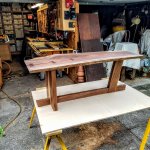 20200802_100846.jpg469 KB · Views: 1,278
20200802_100846.jpg469 KB · Views: 1,278 -
 20200731_135218.jpg485.2 KB · Views: 930
20200731_135218.jpg485.2 KB · Views: 930 -
 20200731_184432.jpg120.2 KB · Views: 903
20200731_184432.jpg120.2 KB · Views: 903 -
 20200730_170911.jpg545.5 KB · Views: 898
20200730_170911.jpg545.5 KB · Views: 898 -
 20200801_085750.jpg155.9 KB · Views: 907
20200801_085750.jpg155.9 KB · Views: 907 -
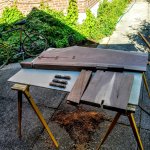 20200801_084349.jpg588.8 KB · Views: 931
20200801_084349.jpg588.8 KB · Views: 931 -
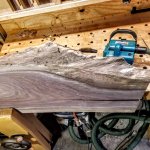 20200724_104114.jpg477.1 KB · Views: 902
20200724_104114.jpg477.1 KB · Views: 902 -
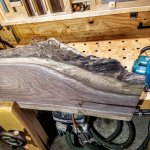 20200724_103725.jpg508.4 KB · Views: 896
20200724_103725.jpg508.4 KB · Views: 896 -
 20200722_144833.jpg494.9 KB · Views: 1,001
20200722_144833.jpg494.9 KB · Views: 1,001 -
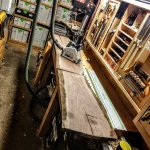 20200722_202706.jpg539.7 KB · Views: 987
20200722_202706.jpg539.7 KB · Views: 987 -
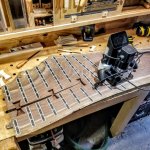 20200724_175302.jpg507.4 KB · Views: 961
20200724_175302.jpg507.4 KB · Views: 961 -
 20200727_115417.jpg479 KB · Views: 911
20200727_115417.jpg479 KB · Views: 911 -
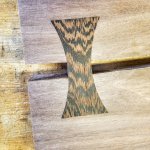 20200727_115436.jpg553 KB · Views: 910
20200727_115436.jpg553 KB · Views: 910




